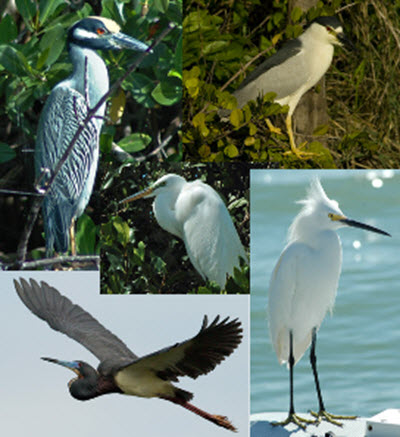 |  |
The Adopt-a-Nest program allows you to symbolically adopt a nest of one of Estero Bay’s wading and diving bird species. These birds are found in colonies on mangrove islands throughout the bay. Your generous donation to the Estero Bay Buddies will be used to assist the Estero Bay Aquatic Preserve in their rookery monitoring program, as well as other resource monitoring and management programs that aim to keep Estero Bay beautiful and healthy.
What’s included:
- Tier One ($30 level): a certificate of adoption, a fact sheet giving you detailed information about your species, mid-season and post-season updates on your species’ nesting activity, and a membership to the Estero Bay Buddies
- Tier Two ($50 level): a certificate of adoption, a fact sheet giving you detailed information about your species, mid-season* and post-season updates on your species’ nesting activity, a membership to the Estero Bay Buddies, and an Aquatic Preserve field guide
- Tier Three ($100 level): a certificate of adoption, a fact sheet giving you detailed information about your species, mid-season* and post-season updates on your species’ nesting activity, a membership to the Estero Bay Buddies, an Aquatic Preserve field guide, and a boat tour by Aquatic Preserve staff of rookery islands in Estero Bay
*due to their late-season nesting habits, the following species may not have mid-season updates: Black-crowned Night Heron, Yellow-crowned Night Heron, Little Blue Heron, Green Heron
How to adopt a nest:
- Choose your level: Tier One, Two, or Three (tiers are based on the nest abundance of each species)
- Choose your species (note: if there are no nests from your chosen species during the nesting period, another species of equal value will be provided to you)
- Click the ‘Add to Cart’ button
Tier One: $30

- Brown Pelican (left)
- Great Blue Heron (top right)
- Double-crested Cormorant (bottom right)
Tier Two: $50

- Yellow-crowned Night Heron (top left)
- Black-crowned Night Heron (top right)
- Great Egret (center)
- Tri-colored Heron (bottom left)
- Snowy Egret (bottom right)
Tier Three: $100

- Great White Heron (top left)
- Reddish Egret (top right)
- Green Heron (bottom left)
- Little Blue Heron (bottom right)
History of Estero Bay Aquatic Preserve’s rookery monitoring program
Estero Bay Aquatic Preserve (EBAP) was designated in 1966, becoming Florida’s first Aquatic Preserve. Established by law, Aquatic Preserves are submerged lands of exceptional biological, aesthetic, and scientific value that are to be maintained in their natural or existing conditions for the benefit of future generations. EBAP covers 11,000 acres of submerged lands, and protection of these lands is critical in managing the wading and diving bird populations that inhabit Estero Bay. The bay has significant wading and diving bird-feeding habitats including oyster reefs, intertidal flats, seagrass meadows, and salt marshes. Additionally, there are hundreds of islands dominated by mangroves that provide vital roosting and nesting habitats. EBAP monitors 25 of these islands every month with the help of volunteers who play an integral role in the rookery monitoring program.
The EBAP rookery monitoring program provides peak estimates of nesting effort for each species of wading and diving bird, monitors population trends, maintains a current atlas of historic and active colonies, documents human disturbance, and records the number of fishing line entanglements and fatalities. Historically, rookery monitoring was conducted inconsistently from the mid-1970s to the early 2000s. In 2007, the Aquatic Preserve recognized the need to create a regular monitoring program to track the trends of imperiled wading and diving birds. Starting in 2008, surveys have been conducted for all active and historically active rookery islands once a month throughout the nesting season, and since 2012, surveys have been conducted year-round due to the extended period of nesting. In order to prevent disturbance, islands are surveyed at a distance of 100-150 feet by two observers using binoculars. Each observed nest is documented by species and nesting stage. Data collected from these monthly surveys are analyzed and included in publications such as the annual South Florida Wading Bird Report.
 |  |
photo credits:
- top of the page: Great Blue Heron with juvenile (John Egaña), Brown Pelican with chick (Melissa Groo)
- tier one photos: Pelican (John Egaña), Great Blue Heron with juvenile (John Egaña), Double-crested Cormorant (Geri Biggs)
- tier two photos: Black-crowned Night Heron (Bob Bachand), Great Egret (Geri Biggs), Tri-colored Heron (Melissa Groo)
- tier three photos: Great White Heron (Geri Biggs), Reddish Egret (Bob Bachand), Green Heron (Melissa Groo), Little Blue Heron (John Egaña)
- bottom of page: Snowy Egrets (Melissa Groo)
- all additional photos: Estero Bay Aquatic Preserve
The Estero Bay Buddies is a non-profit 501(c)(3) organization.
All donations are tax-deductible and greatly appreciated.